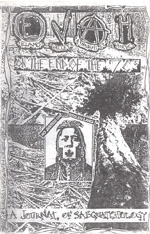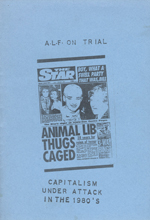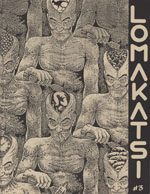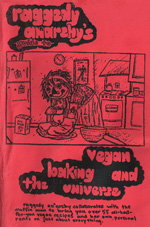The Archives
-
One-off publications
Flamethrower
11.12.14 | PermalinkFlamethrower (1986. London, England)
We recently received this publication from another archivist but have very little information about its origins. Still, with a flame throwing, angry feminist on the cover how can you go wrong?
The interior pages are a pastiche of radical thoughts and images varying greatly in quality, but even in the paper’s more juvenile moments I sense the work of people sincerely concerned with creating a free society. How they thought rioting alone would get them there is another matter…
If you have any information about Flamethrower please contact us HERE.
…
-
One-off publications
A.L.F. On Trial – Capitalism Under Attack In The 1980’s
10.29.13 | PermalinkA.L.F. On Trial – Capitalism Under Attack In The 1980’s (1987. England, city of publication unknown.)
On February 5th of 1987 ten British animal liberationists were sentenced to an aggregate of 38 years after a trial prosecutors had designed to “break the back of the ALF.” This case, popularly referred to as the Sheffield Trial, set precedents not only in the UK, but worldwide for the manner in which vegan militants would be tried by the state and media.
Although the Sheffield Trial failed in its goal to end underground direct action for non-humans, it did take a serious toll on the movement. Ronnie Lee was sentenced to 10 years, Roger Yates skipped bail and went on the run, and several others were taken out of the struggle for lengthy periods. The negative media blitz during the trial was among the first to create a popular association between the terms “animal rights” and “terrorist.” Worst of all, Sheffield was the first case in which the charge of “Conspiracy to Commit Criminal Damage” was upheld, essentially allowing radical media producers (In this case Ronnie Lee and the SG Newsletters) to be held responsible for the actions of others the authors had never met or otherwise interacted with- in fact, these other “conspirators” didn’t even have to be known to the authorities. All that needed to be shown was that a publication showed approval for an illegal act and that those acts then continued to occur. (Other courts disagreed with this novel interpretation of the law however, most notably the appeals court in the GANDALF trial.)
Parallels between this case and that of the SHAC 7 and others are clear, but little has been done to learn from the earlier trial. Luckily, an anarchist analysis of the court proceedings from 1987 has survived in the form of this brief, snarky pamphlet.
…
-
Periodicals
Lomakatsi
09.07.12 | PermalinkLomakatsi #1, 2, 3, and 4 (1987-1989, Washington, DC)
Many of the participants in the first boom of U.S. animal liberation activity were radicals, and not just when it came to their critique of non-human slavery. As I have mentioned in previous posts, speciesism is so intrinsic to most cultures that people embracing a pro-animal ethic almost always came from the fringes. These early pioneers pushed the message, took direct action, and put the plight of animals front and center in works of art, music, and literature. What became of these rebels when the movement became more mainstream, and thus more profitable to the careerists at national organizations? As a generation of gray, corporate pseudo-activists began to wield suits and ties instead of spanners and bolt cutters the old guard revolted in a variety of ways- one of which was an eclectic, anarchist journal known as Lomakatsi.
Taking the Hopi word for “Life in Balance,” a small collective of artists and activists set out to reject the dominant themes running through other, tamer publications. More than that, they started a project to live communally on a small parcel of land and experiment with more sustainable, less technological ways of living. By sharing their space with each other, and their thoughts with the world, the rebels continued to have an impact on the direction of the mvoement.
During it’s short life, Lomakatsi circulated about 1,000 copies per issue, introduced anti-civilization themes to AR folks through articles by John Zerzan, (And a letter from Feral Faun in one issue!) and stirred up plenty of controversy. Each issue contained DIY instructions for sabotage, oddball illustrations and comics, and advocacy for some ideas that were challenging to say the least. Their intentional community eventually stopped producing a journal, but those following animal liberation history will certainly see the influence that Lomakatsi had on our movement’s dialogue as we moved into the 1990s.
…
-
One-off publications
Elaho Valley Anarchist Horde on the end of the 7Cs: A Journal of Sasquatchology
04.23.12 | PermalinkElaho Valley Anarchist Horde on the end of the 7Cs: A Journal of Sasquatchology (2001, Victoria, Canada)
“The sun shines brightly in the yard, the sky is clear, the air fresh and bracing. Now the last gate will be thrown open, and I shall be out of site of the guard, beyond the bars, – alone! How I have hungered for this hour, how often in the past years have I dreamed of this rapturous moment – to be alone, out in the open, away from the insolent eyes of my keepers! I’ll rush away from these walls and kneel on the warm sod, and kiss the soil, and embrace the trees, and with a song of joy give thanks to Nature for the blessings of sunshine and air.” Alexander Berkman, Prison Memoirs of an Anarchist.
Upon my own release from prison I traveled to Seattle from Sheridan, Oregon to turn myself in to a halfway house. I too was an anarchist in the hands of the enemy, and while my incarceration was not as long or harsh as Berkman’s, his memoir contains long portions – sometimes entire pages – that feel so familiar it seems as though I wrote them myself. Several times in the final chapter he mentions a longing for wilderness, an urge to run from the dead cities of the northeast into the forests. On that ride from one lockup to another I knew why. Civilization is inherently confining, and even outside of the greybar hotel most of our lives consist of moving from one box to another in a continuous and agonizing march that we have little power to control. Looking out the windows of my friends car I wanted the passing sprawl to be sucked into the soil and replaced with life, beauty, and liberty.
The nature of incarceration can certainly make a person think about the incarceration of nature, but even those anarchists who have been lucky or smart enough to stay out of state custody often get it. If you are opposed to the artificial hierarchies of class, why support the equally arbitrary hierarchies based on species? If you think that forests have less worth than humans than I say you haven’t met enough cops! There isn’t one authority figure on earth I wouldn’t trade for a tree, and anyone who would argue the opposite is a moron. But forgive my rambling, I have written all the above because this wonderful DIY zine has sparked my sense of rebellion and wildness!
The end of the 90s and the early 2000s was a busy time for forest defenders, and across the globe direct action campaigns for wilderness were abundant and inspiring. There are many famous examples, and while Warner Creek and the anti-roads campaigns of England may have stolen the spotlight, one rugged crew in British Columbia carried on an overlooked battle that every activist should know about. If you like raging warrior grannies, sabotage, unlikely coalitions, and open revolt against corporations and their governmental subsidiaries, then you ought to read up on the history of actions in the Elaho, Squamish, and Simms valleys. This zine, written by members of the Elaho Valley Anarchist Horde as both a primer for new activists coming to the Elaho and a means of publicizing the campaign, is an excellent introduction.

-
Most Popular, One-off publications
Got the Hollowpoints for the Snitches
03.13.12 | PermalinkGot the Hollowpoints for the Snitches (2005, United States)
The greatest weapon in the government’s repressive arsenal is the snitch. These sorry examples of humanity provide big brother with an insider’s view of communities of resistance, spread fear and distrust in revolutionary circles, and gift law enforcement with profiling tools to find likely dissenters in the future. Dealing with this problem is one of the most difficult challenges of a militant movement.
While the title of this zine (Taken from Dr. Dre’s Let Me Ride) may seem like unnecessary posturing, the contents contain an intelligent examination of the historical role of snitches, how other movements have dealt with them, and a rogues gallery complete with contact information for dozens of traitors. Written during the early days of the Green Scare, it offers a look into the mindset of frontline activists during a time when snitching was epidemic.
(NOTE: If you have arrived at this page from one of Corey Wrenn’s blogs please be aware that this document was not produced by or for the Animal Liberation Front as she often claims. Furthermore, be aware that, for better or worse, no one listed inside has been subjected to violence as a result of their listing.)
…
-
Most Popular, One-off publications
Raggedy Anarchy’s Guide to Vegan Baking and the Universe
02.23.12 | PermalinkRaggedy Anarchy’s Guide to Vegan Baking and the Universe (1989? Carmichael, CA)
Consumer culture is rampant in its appropriation and assimilation of radical ideas, taking things that were once revolutionary (including the word “revolutionary” itself!) and turning them into products to be purchased or new forms of advertising. DIY Skater culture became a vehicle for hocking Mountain Dew, Tylenol, and Nike shoes, hardcore music influenced the crappy, commercial “now I’m singing, now I’m yelling” garbage heard on the radio today, and in a world where sorority girls have knuckle tattoos and think Discharge is a clothing brand, can punk still be a threat? These subcultures may have never truly threatened the system, but at one time they provided a safe space from it, and in that space some truly liberatory ideas flourished.
If you have grown up in a world where vegan cookies are sold at supermarkets and every animal free product imaginable can be bought on the internet, veganism might just seem to be one more compartment in the consumerist toolbox. But there was a time when this wasn’t so. In the early days of veganism you had to be seditious to even consider such a thing. It was unheard of, and given cultural resistance to the changing of food choices, it was also rebellious. While many health oriented and religious groups had advocated an animal free diet, animal rights oriented veganism was uncharted territory. (And at times unwelcome in the animal rights community! Many New Zealand anti-vivisection societies ran newsletter articles in the late 70’s and early 80’s warning of possible “infiltration” efforts by vegans!) On it’s path to mainstream acceptance, the first pioneering steps were taken very often by punks, hardcore kids, and others existing on the fringes.
Because being a vegan was such a new concept at the time, people simply did not know how to do it. Recipes and helpful hints began spreading through album liner notes, self published cook-zines, and the network of all ages venues that began springing up in the late 1970s. Making veganism accessible to the young and poor brought animal rights into communities that were already resistant to cultural norms, and soon animal liberation joined the roster of causes tattooed on the hearts of misfits everywhere. Diets were changed, but more importantly, action was taken. For proof we present Raggedy Anarchy, an amazing cook-zine that was hugely influential on the likes of Isa Moskowitz and others, written by a young punk and hunt saboteur from California.
Raggedy Anarchy will help you make delicious cakes, but it will also spark your desire to subvert the omnicidal paradigm! Sometimes funny, sometimes introspective, and always inspiring, we post this classic in the hopes of making Snacktivism a threat again and convincing our readers to “bake for themselves what tomorrow never brings!”
…












